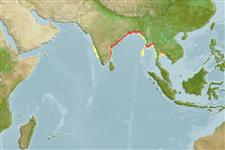Environment: milieu / climate zone / depth range / distribution range
Ökologie
seewasser; süßwasser; brackwasser demersal; amphidrom (Ref. 51243); tiefenbereich ? - 25 m (Ref. 31582). Tropical; 24°N - 11°N, 71°E - 102°E (Ref. 57343)
Eastern Indian Ocean and Western Pacific: west coast of India to Thailand. Probably occurs in Malaysia (Ref. 5756) and Laos (Ref. 9497).
Size / Gewicht / Alter
Maturity: Lm ? range ? - ? cm
Max length : 30.0 cm NG Männchen/unbestimmt; (Ref. 94495); common length : 17.0 cm TL Männchen/unbestimmt; (Ref. 3479)
Rückenflossenstacheln (insgesamt): 7; Rückenflossenweichstrahlen (insgesamt): 14-15; Afterflossenstacheln 2; Afterflossenweichstrahlen: 11 - 13
Lives over sandy bottoms, regularly entering freshwaters during breeding season. Feeds mainly on crustaceans (especially shrimps), small fishes and benthic organisms. Marketed fresh (Ref. 3479).
Life cycle and mating behavior
Geschlechtsreife | Fortpflanzung | Ablaichen | Eier | Fecundity | Larven
Motomura, H., S.O. Kullander, T. Yoshino and Y. Iwatsuki, 2002. Review of seven-spined Polynemus species (Perciformes: Polynemidae) with designation of a neotype for Polynemus paradiseus Linnaeus, 1758. Ichthyol. Res. 49(4):307-317. (Ref. 31582)
IUCN Rote Liste Status (Ref. 130435)
Bedrohung für Menschen
Harmless
Nutzung durch Menschen
Fischereien: kommerziell
Mehr Information
NamenSynonymeMetabolismusRäuberÖkotoxikologieFortpflanzungGeschlechtsreifeAblaichenSpawning aggregationFecundityEierEientwicklung
ReferenzenAquakulturAquakultur ProfilZuchtlinienGenetikElectrophoresesVererbbarkeitKrankheitenVerarbeitungNutrientsMass conversion
PartnerBilderStamps, Coins Misc.LauteCiguateraGeschwindigkeitSchwimmstilKiemenoberflächeOtolithsGehirngrößeSehfähigkeit
Tools
Zusatzinformationen
Download XML
Internet Quellen
Estimates based on models
Preferred temperature (Ref.
123201): 27.5 - 28.9, mean 28.4 °C (based on 157 cells).
Phylogenetic diversity index (Ref.
82804): PD
50 = 0.5039 [Uniqueness, from 0.5 = low to 2.0 = high].
Bayesian length-weight: a=0.00490 (0.00298 - 0.00805), b=3.08 (2.94 - 3.22), in cm total length, based on LWR estimates for this species & (Sub)family-body (Ref.
93245).
Trophic level (Ref.
69278): 3.9 ±0.60 se; based on food items.
Widerstandsfähigkeit (Ref.
120179): hoch, Verdopplung der Population dauert weniger als 15 Monate. (Preliminary K or Fecundity.).
Fishing Vulnerability (Ref.
59153): Low vulnerability (15 of 100).
